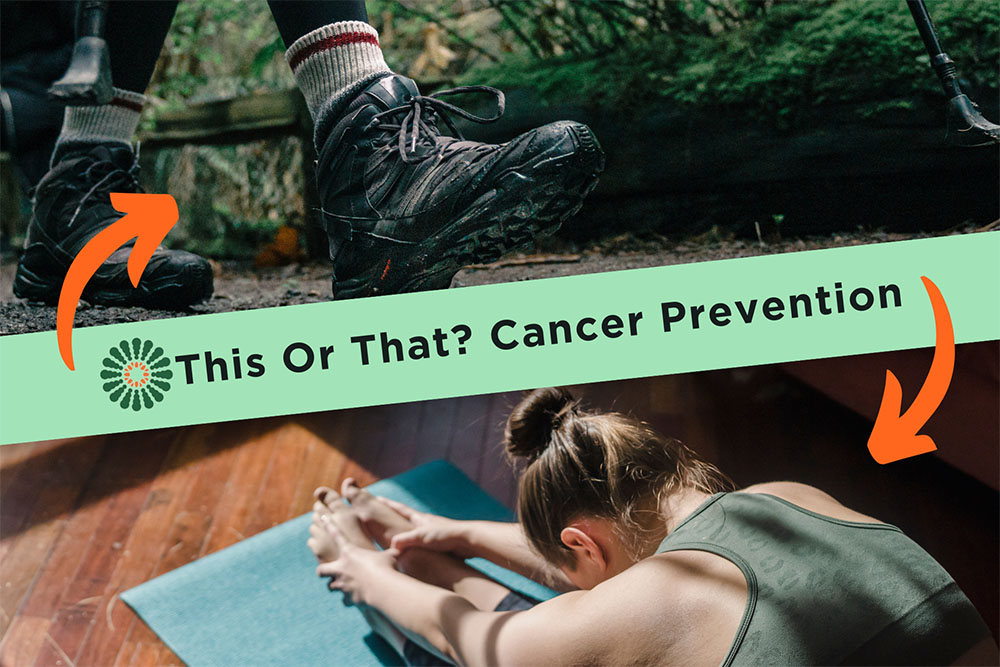Cancer is a complex disease influenced by genetics, lifestyle, and environment, but research shows that nearly half of all cancer cases can be prevented through healthy choices and risk reduction strategies. While no single action guarantees protection, taking small, meaningful steps can make a big difference.
This Cancer Prevention Month, try some of these science-backed recommendations to lower your cancer risk. We’ve made it easy for you by listing 12 ways to reduce your cancer risk and two actionable changes for each that you can make today… just choose this or that. (Bonus: If you love a challenge, feel free to try both!)
1. Quit Smoking (or Never Start)
According to the CDC, tobacco use is the leading preventable cause of cancer. It’s linked to at least 12 types of cancer, including esophageal, throat, and bladder cancer. Almost nine out of every 10 cases of lung cancer is linked to tobacco products. Even secondhand smoke exposure increases risk.
This: Call 1-800-QUIT-NOW for free support to quit smoking today.
or
That: Talk to your doctor about medications that help you quit.
2. Protect Your Skin from the Sun
UV radiation from the sun and tanning beds is a major cause of skin cancer, including deadly melanoma. It damages skin cells’ DNA, sometimes causing cells to grow out of control and form tumors. Daily protection is essential, even on cloudy days. Avoid tanning beds as a general rule and protect your skin by doing one of the following:
This: Add a broad-spectrum SPF 30+ sunscreen to your skin care routine every day.
or
That: Switch your base makeup or morning moisturizer to one that includes a sunscreen of SPF 30+.
3. Maintain a Healthy Weight
Fat cells produce a variety of proteins that cause high levels of insulin and other hormones, which may encourage cancer cell growth. Risk for cancer increases with having excess visceral fat and significant excess body fat. Even losing a small amount of weight can help reduce risk.
This: Reduce your portion sizes (using a smaller plate to give the illusion of more food can help).
or
That: Swap sugary drinks for water, and drink a big glass before meals.
4. Eat More Fruits and Vegetables
A diet rich in plant-based foods provides antioxidants and fiber, which help reduce inflammation and protect against certain cancers. They also contribute to a healthy weight. In general, those with the most color—dark greens, reds, oranges, and yellows—contain the most nutrients.
This: Fill half your plate with colorful fruits and vegetables at every meal.
or
That: Eat one cup of raw veggies at every meal.
5. Limit Red and Processed Meat
High consumption of red and processed meats (like bacon, sausage, and hot dogs) has been linked to colorectal cancer. More research is needed, but the increased risk may be explained by the iron and fat content in red meat, and/or the salt and nitrates/nitrites in processed meats. Additionally, when meat is cooked at high temperatures, substances are formed that may cause cancer.
This: Swap red meat for lean proteins like fish or poultry.
or
That: Aim for a vegetarian meal twice a week.
6. Be Physically Active
Physically active adults have a significantly lower risk of developing several commonly occurring cancers, as well as lower risk of several other cancers. If you are a cancer survivor, getting regular physical activity helps give you a better quality of life and improves your physical fitness. Some studies even suggest it can reduce the risk of cancer recurrence.
This: Take a brisk 30-minute walk five times a week.
or
That: Download an app that gamifies exercise, making it fun.
7. Limit Alcohol Consumption
Alcohol is a known carcinogen linked to cancers of the breast, liver, esophagus, and possibly prostate. The more you drink, the higher your risk. Some studies show that drinking three or more alcoholic drinks per day increases the risk of stomach and pancreatic cancers. All kinds of alcoholic drinks increase the risk of cancer, not just hard liquor.
This: Stick to moderate drinking—no more than one drink per day for women and two for men.
or
That: Go “dry” for a month and see how you feel. You might find that your alcohol cravings are significantly reduced after abstaining for a short period.
8. Get Screened for Cancer
Early detection saves lives. Screenings for breast, cervical, colorectal, and skin cancer can catch disease early, when it’s most treatable. Screening recommendations differ based on gender, age, medical and family history, and other risk factors. If you are a current or former smoker, low-dose CT lung cancer screening may be available.
This: Take a day and schedule your routine cancer screenings based on age and risk factors.
or
That: If you’re unsure what needs to be scheduled, make an appointment with your primary care doctor. If you’re a current or former smoker, talk to your doctor about low-dose CT screening for lung cancer.
9. Avoid Harmful Chemicals
Exposure to environmental toxins like pesticides, industrial chemicals, and air pollution may contribute to cancer risk. It’s difficult to avoid exposure to many of the toxins in our daily lives, but there are steps you can take. Besides the options below, the Environmental Working Group offers additional suggestions for reducing toxic exposures in the home.
This: Switch out your cleaning and laundry products for natural ones.
or
That: Plant a small vegetable or herb garden using natural fertilizers and non-chemical pest-management practices.
10. Stay Up to Date on Vaccines
HPV and hepatitis B vaccines can help prevent cancers caused by viruses. The HPV vaccine protects against the most common cancer-causing forms for HPV. The hepatitis B vaccine can help prevent liver cancer.
This: Check vaccination records to ensure you and your children are vaccinated against HPV and hepatitis B.
or
That: Make an appointment to discuss vaccination with your doctor.
11. Reduce Chronic Stress
While studies have not shown a direct link between stress and cancer, long-term stress can weaken the immune system and contribute to behaviors that increase cancer risk, such as smoking or overeating. We can never fully eliminate harmful stressors from our lives, but properly managing stress can improve our quality of life and overall health.
This: Practice stress management techniques like meditation, yoga, or deep breathing daily.
or
That: Take a daily walk in nature.
12. Get Enough Sleep
Researchers are studying how chronic sleep problems may increase cancer risk by disrupting the body’s sleep cycle over time. One theory suggests that not getting enough sleep weakens the immune system, making it less effective at preventing abnormal cell growth that can lead to cancer. While poor sleep has not been definitively linked to cancer, getting a good night’s sleep is an important part of maintaining good health.
This: Aim for 7-9 hours of quality sleep per night and maintain a regular sleep schedule.
or
That: Avoid screens for at least half an hour before bedtime—instead, read a book or meditate.
Start Today
You don’t have to make all these changes at once. Start with one habit and build from there. Each step you take brings you closer to a healthier future.
Sources:
https://www.aicr.org/cancer-prevention/recommendations/be-a-healthy-weight
https://www.cdc.gov/tobacco/campaign/tips/quit-smoking/index.html
https://www.cdc.gov/cancer/risk-factors/tobacco.html
https://progressreport.cancer.gov/prevention/diet_alcohol/red_meat
https://www.cdc.gov/physical-activity-basics/health-benefits/lowers-risk-of-cancer.html
https://www.cancer.org/cancer/risk-prevention/diet-physical-activity/sleep.html



